The Buffalo Bayou Park Cistern is a former drinking water reservoir built in 1926 for the City of Houston. BBP restored and repurposed the 87,500 square-foot Cistern into a magnificent public space for tours, performances, and art installations.
Reservations are required to visit the Cistern. Children ages 9+ only. Please see options below.
Learn More About The Cistern
ON VIEW: FEBRUARY 2 – NOVEMBER 10 2024
Rossin’s Haha Real is an original, site-specific media and sound installation created for the Buffalo Bayou Park Cistern. This work will transform this vast industrial relic into a unique world, drawing on both innovative technologies and ancient storytelling methods. Taking key inspiration from the classic children’s story, The Velveteen Rabbit , Rossin’s work will invoke themes of transformation and loss.
Wednesday 10am – 6:30pm
Thursday – Friday 10am – 7:30pm
Saturday – Sunday 11am – 7:30pm
Tours held every hour on the hour, excepting 12pm and 4pm.
BOOK TICKETS FOR HAHA REAL
Una instalación de sonido y medios específicos del sitio realizada por la artista Rachel Rossin. En un viaje alrededor de la Cisterna, personajes y símbolos aparecerán en pantallas de hologramas LED, mientras que las características cinéticas y la iluminación aumentan la arquitectura del espacio y juegan con la superficie reflectante del agua. Inspirándose clave en fuentes como el clásico cuento infantil The Velveteen Rabbit , la obra llevará a los espectadores a un viaje que cuestiona tanto lo real como lo imaginario.
Sábado a 1pm
RESERVAR ENTRADAS PARA HAHA REAL
Learn about the history and architecture of the Cistern on this fully guided tour.
Wednesday – Sunday at 12pm and 4pm
BOOK A HISTORY TOUR
Book a unique group outing with a private, docent-led Cistern tour for up to 30 people.
- Wednesday – Sunday 12pm – 4pm, pending availability.
- Private Tours are not available on the first Thursday of the month.
BOOK A PRIVATE CISTERN TOUR
Practice meditation in the Cistern, led by Union is Creation. Singing bowls and wind chimes encourage mindfulness and connectivity in this unique acoustic space. Cushions or mats are welcome.
Saturdays and Sundays at 10am and Wednesdays at 7pm
BOOK SOUND HEALING MEDITATION TICKETS
TOUR INFORMATION
- Reservations are required to visit the Cistern.
- No children under the age of 9 are allowed inside of the Cistern.
- Please allow approximately 30 minutes for parking/check-in. Latecomers may not be admitted, and tickets are non-refundable.
- Full participation in the tour requires walking a distance of one-quarter mile in 25 minutes. Accommodations can be made for those needing stationary or seated tours.
Limited, free parking is available adjacent to the Cistern in The Water Works parking lot and along Sabine Street.
Additional parking options in the area include City of Houston Parking Lot H and along Allen Parkway.
PRICING AND DISCOUNTS
- $2 discount for military, youth (ages 9-17) college students, and seniors (65+). Must present I.D. upon checking in.
- Buffalo Bayou Partnership Members receive discounted tickets for select tours. Learn more about Membership here .
- All Cistern tours are free on the first Thursday of the month, reservations are required.

Hop aboard Buffalo Bayou Partnership’s pontoon boat to see Houston from a new angle! From nature-focused tours, guided history tours, or your own private celebration, there’s something for everyone. Children ages 4+ only.
Take a cruise through the heart of Houston with your friends and family on one of BBP’s public boat tours. Throughout the year, BBP offers a variety of ticketed pontoon boat experiences, including 45-minute nature-focused cruises, 90-minute rides to watch the Waugh Bridge Bat Colony emerge at dusk with a wildlife expert, opportunities to learn the behind-the-scenes of Houston’s past with a historian, and themed boat tours to celebrate the season.
Great for friends and family, team-building with co-workers, or hosting out-of-town visitors, BBP’s private pontoon boat tour cruises through the heart of downtown along historic Buffalo Bayou, past iconic sites and industrial relics. The boat can accommodate up to 21 guests ages 4+ only. Outside food and beverages are welcome. Add a historian for an additional $175. View the Private Boat Tour FAQ here .
Book Your Private Charter Here
- For safety reasons, children under the age of 4 are not allowed on the pontoon boat.
- The pontoon boat can accommodate up to 21 guests at a time.
- Please note that ticket purchases are non-refundable and support the work of Buffalo Bayou Partnership. Guests will receive a full refund in case of cancellation due to weather.
DEPARTURE LOCATION
Allen’s Landing: 1019 Commerce Street (at Main Street). Proceed down to the wharf via the cascading stairs (adjacent to Sunset Coffee Building, the 3-story brown brick building). The boat will be docked at the wharf.
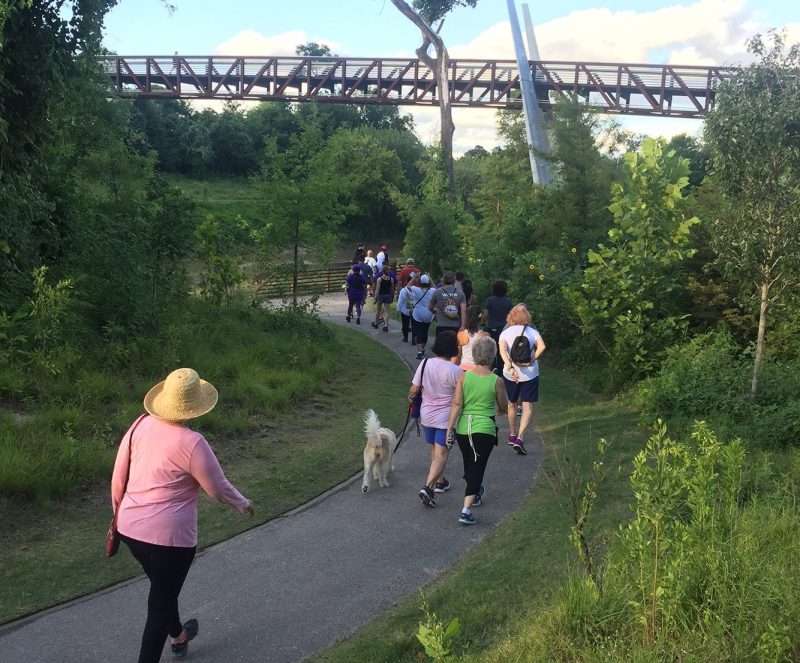
Enjoy expert-led tours along Buffalo Bayou on topics including wellness practices, the ecology of the bayou, the meanings and musings behind our public art, and more.
Join a Wellness Walk led by Laura Conely, founder of Urban Paths . All are invited to walk the trails and pathways of Buffalo Bayou Park while discussing topics including mental and physical health as well as the benefits of being exposed to nature.
Learn about the native flora and fauna along Buffalo Bayou! Follow along this discovery tour of the bayou ecosystem with Nancy Greig, former director of the Cockrell Butterfly Center at the Houston Museum of Natural Science. Nancy loves the outdoors, especially beekeeping and tending birdhouses in her garden.

Take one of our self-guided tours at your own pace and learn interesting facts about areas along Buffalo Bayou Park.

Buffalo Bayou Park is full of the wonders of nature. Use this guide to explore and experience everything Houston’s greatest natural resource has to offer on your next visit.
View The Guide
The Buffalo Bayou Revealed audio tour is presented by Houston Public Media . This audio experience provides you with interesting facts about areas along Buffalo Bayou Park. Listen below, or download the tour as a .zip file.


Visiting the Bull Run Watershed

About Bull Run Watershed tours
During the tour, a professional natural resources educator leads participants through the Bull Run Watershed, discussing Portland's drinking water sources and system. All information is intended for a general audience.
If you're a teacher interested in Bull Run tours, check out our school programs.
We offer tours from June through October, with a mix of weekdays and weekends. We post tour dates in June. If you'd like to receive an email when we post the season's tour dates, sign up for our notification list .
Tours cost $22.69 - $43.89 per person. There is a $20 - $40 sliding scale for the transportation costs and an online service fee.
The Water Bureau is proud to offer the community opportunities to visit Portland’s water system. Your registration fee helps to offset the cost of making this unique opportunity available for our community. Please contribute what you are able. If a contribution is a barrier, please let us know.
Sign up for a tour online
What to expect on the tour
The tour is an all-day affair. We usually leave Portland at 8:30 am and return around 4:30 pm. Here's a typical tour day:
- Meet the bus in Portland at 8:15 am
- Bus departs at 8:30 am
- Visit the Columbia South Shore Well Field , the city's groundwater source
- Walk through old-growth forest in the upper reaches of the Bull Run Watershed
- Eat lunch at the Historic Bear Creek House , overlooking Dam 1 and Reservoir 1
- Tour the city's 1929 concrete dam , and the adjacent forest
- Drive across the city's 1962 earth and rock fill dam
- Visit the lower Bull Run River and learn about the fish that live there
- Arrive back in Portland at 4:30 pm
Because of the distances involved in the tour, we spend much of the day on the bus. We usually offer an optional one-mile hike through old-growth forest.
Preparing for your trip
Dress for the weather and wear comfortable shoes..
Weather in the watershed tends to be cooler and wetter than in the Portland area, so bring extra layers and prepare for rain. Much of your tour will take place inside a vehicle, but you will have opportunities to walk on rough trails and primitive roads.
Wear clean shoes or boots.
To protect water quality, please clean your shoes before the tour. Sometimes shoes can transport fecal matter (from dogs, cats, cows, etc.) or seeds from invasive plants.
Bring enough food and drinks to last the entire day.
Tour schedules do not allow time to stop for provisions. You'll have opportunities to refill your water bottle during the day.
Consider the restroom situation.
Restrooms can be 1.5 to 2 hours apart. If limited restroom availability presents an issue for you, please contact us.
Bring official photo identification and a completed waiver form .
For security, all participants must present a signed liability waiver, and adults (18 years and older) must provide identification. Participants under 18 years old must have the waiver signed by a guardian, but do not have to provide identification.
Consider your health.
The tour area is remote. Water Bureau staff carry emergency radios and are trained in first aid; however, cell phones do not work and emergency care can be more than an hour away. If you know you may need medication (including over-the-counter drugs), please bring your own.
Read these guidelines about protecting the drinking water.
We require that participants:
- Refrain from smoking, vaping, or using e-cigarettes.
- Do not touch the water or put anything in the water.
- Use only the restroom facilities provided.
- Take home any trash. Littering—or putting any foreign material on the land—is prohibited.
- Stay with the group at all times.
Water Resources Education
See something we could improve on this page? Give website feedback .

Spring Valley Reservoir
20 miles from Moscow, Idaho is the Spring Valley Reservoir, locally known for its habitat and bird observation features. Song birds, water birds, and water fowl can all be spotted in the 99 acre region. Boating, kayaking, canoeing, and fishing are permitted on this site in the lake, as well as Idaho Birding Trails to tour some of Idaho’s greatest bird inhabitants. There are tent camping sites available with parking and restroom facilities.
Directions: From Moscow, drive E on Hyw 8 through Troy; at mp 17 go L (n) onto Spring Valley Road ~3 mi bearing left at all three forks to the reservoir.
(208) 799-5010
Change Location
Find awesome listings near you.
North Bend Escapes

Cedar River Watershed Education Center

Cedar River Watershed Overview
The City of Seattle owns the Cedar River Watershed, which covers 90,638 acres. The watershed supplies clean drinking water to 1.4 million people in the Seattle area. The Cedar River starts in the Cascades near the Kittitas King County Line and flows into Lake Washington at Renton. Chester Morse Lake is the main storage reservoir for the Cedar River Watershed System. The watershed is not open to the general public.
However, the Cedar River Watershed Education Center allows visitors to learn about the complexity and interactions among drinking water, forests, and wildlife. At the Education Center, visitors have a chance to experience the watershed through exhibits, information, watershed tours, field trips, and special events. The staff have focused special events on Seattle’s drinking water, history, wildlife, and more. Inside the main building you can follow the path of our drinking water as is flows from the sky to our faucet. With maps and visual aids detailing the path Seattle’s drinking water takes it is a fascinating lesson in our eco system and is VERY kid friendly. This place is a great place to visit and you cannot beat the price of admission. (Free)
The Milwaukee Railway Company was first granted right of way through the Cedar River Watershed in 1907 to build their rail line (which is now the Palouse to Cascades Trail). The railroad workers lived in a town called Moncton along a lake called Rainy Season Lake. In 1914 the City of Seattle began building a masonry dam on the Cedar River between Rattlesnake Lake and Chester Morse Lake. This was to generate electric power for the City.
Due to unforeseen engineering issues, the following spring, the water started rising at Rattlesnake Lake below the dam at a rate of 1 foot per day and the lake above was dropping an inch per hour. The added water in Rattlesnake Lake flooded most of the town of Moncton. The City of Seattle condemned the rest. When the water level of Rattlesnake Lake drops enough, you can see some of the old foundations from the short lived town of Moncton.
Watershed tours include dam tours, old growth guided walks, wetlands tour, fungi tours and many more. There are also guided hikes in winter. The signature tours are a 1-hour family watershed tour and a 2.5 hour watershed tour. The 1-hour tour includes a drive to the historic townsite of Cedar Falls and a visit to Cedar Falls (the waterfall). The 2.5 hour trip also includes walking across Masonry Dam and seeing Chester Morse Lake. There are also special all day tours which are held on an infrequent basis and involve more walking.
Check Cedar River Watershed website for details and reservations.
Inquire at the Center about room rentals along with special events requests such as weddings, parties, etc.
Event Permits
Inquire at the Center about permits for sporting events, races, community gatherings of 30 or more, and film productions.
The Center will give information about trail conditions, watershed tours, and recreation area for special events when you contact them.
Phone numbers: (206) 733-9421 or (425) 831-6780
Email: [email protected]
Nearby Activities
The Cedar River Watershed Education center is situated on Rattlesnake Lake. Just behind it is the western terminus of the Palouse to Cascades Trail (Cedar Falls). The Cedar Falls station for the old Milwaukee railroad was renamed from Moncton in 1915 when the city was flooded out. Rattlesnake Lake also is the main trailhead for the Rattlesnake Ledge Trail with access to Rattlesnake Mountain . It’s also the eastern terminus for the Snoqualmie Valley Trail.
We are Here

Get up to a $100 rebate on a WaterSense-labeled toilet.
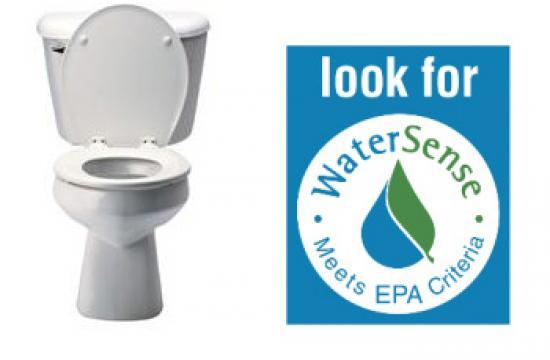
Save your business water and money with Denver Water’s rebates .
Contractors
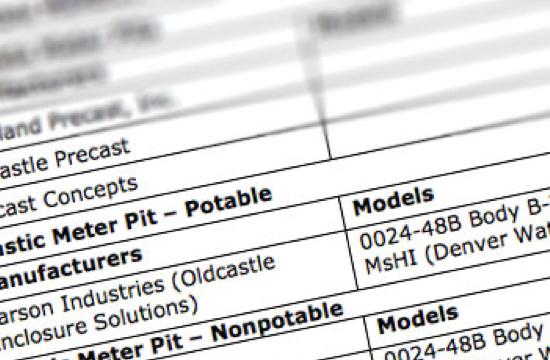
Our Design Standards page gives you everything you need at your fingertips.
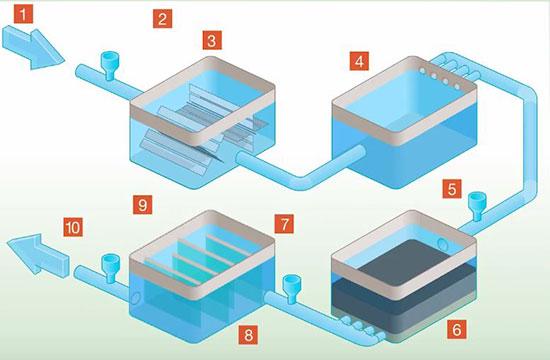
Treat your curiosity about water quality to a virtual tour of our potable treatment process.
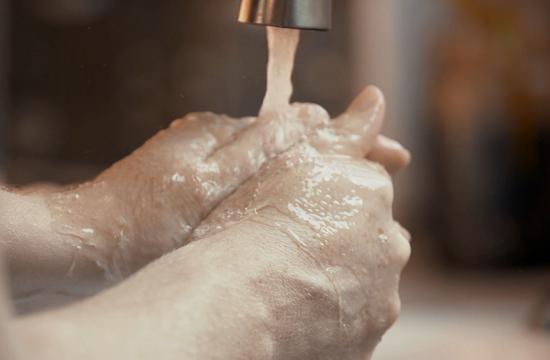
Follow the journey of water from snowflake to tap.
Construction
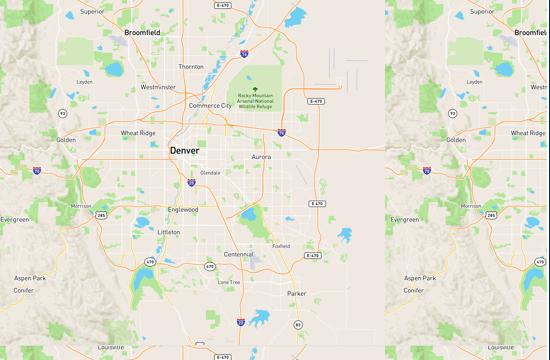
Find out what projects we're doing to improve our system.
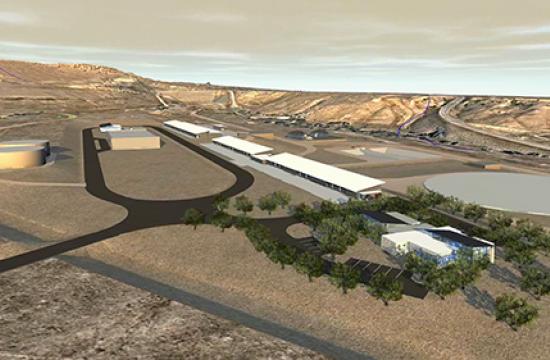
We are upgrading and modernizing the northern portion of our water system.
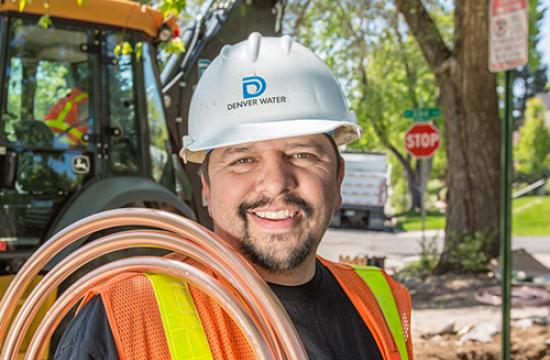
We are committed to being a good neighbor during construction projects.
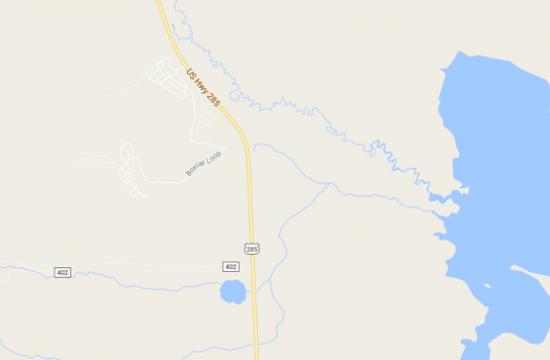
Find your next place to play at any of our recreation areas .
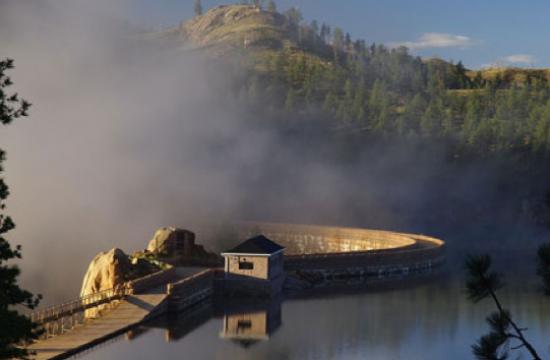
Hike the Gill Trail to catch scenic views of Cheesman Reservoir .
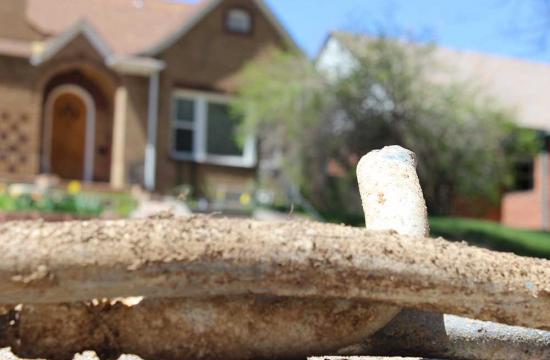
Have questions about lead ? Get some answers.
Main navigation
Recreation areas, there's more to water than drinking it..
Denver Water's reservoirs, canals and canyons offer lots of opportunities to get out and play. Explore our recreation sites for ways you can enjoy Colorado's great outdoors.

The Waterworks Museum will be CLOSING at 3:00pm on Saturday, June 8th for a private event. We will also be CLOSED all day on Friday, June 14th as we prepare for Waterfest. We apologize for any inconvenience.
Engineered to engage curious minds, the waterworks museum interprets the unique stories of one of the country's first metropolitan water systems through exhibitions and educational programs on engineering, architecture, social history, public health, and safe water access., the museum is open today from 11am-4pm, how do i get there, upcoming events.
Current Exhibit
A walk around the chestnut hill reservoir.
Join us for this unique look at the Chestnut Hill Reservoir (past and present) and submit your photos to become a part of this special exhibition!
Great Engines Hall
The centerpiece of the Waterworks Museum is its collection of steam engines. Three original coal-powered, steam-driven water pumps are preserved at the Museum and are monuments to 19th century technology and innovation. Leavitt, Worthington, and Allis stand in the Great Engines Hall and reach more than 3 stories tall. Walk around each and see the multitude of perfectly engineered parts that pumped million gallons of freshwater a day into the City of Boston.
What's On the Calendar?
How do i book an event at the museum, connect with us.
- HOW IT WORKS
Underground Cistern

Known locally as Yerebatan Sarayi (meaning Sunken Palace) or Yerebatan Sarnici (Sunken Cistern) , this underground water cistern was the major water reservoir of Constantinople . The water was transported from the Belgrade Forest by the immense Byzantine aqueducts ( Valens Aqueducts ) . You can visit the Underground Cistern either with our One Day in Istanbul or Istanbul Layover Tour.
When was it built?
It was built during the reign of Emperor Constantine in the 4th Century but greatly enlarged by Justinian in 537 AD, and used as water storage for the Great Palace during Byzantine times and for the Topkapi Palace under the Ottomans.
How was the sunken cistern discovered?
It fell into disuse, but was rediscovered by Frenchman Petrus Gyllius in 1545, who revealed it after investigations he began when he found locals selling very fresh fish in the nearby streets – their houses were located above it and they had sunk wells into it and sometimes caught fish from it.
This eerie and atmospheric setting has attracted thriller writers across the ages. From seeing the Basilica Cistern James Bond rowed across in From Russia With Love (1963) to the exciting climax featuring Robert Langdon in Dan Brown's Inferno (2013) , there can't be many locations as historical and unusual as this.

Amazing Facts
- There are 336 giant columns (mostly Ionic or Corinthian in style) supporting the structure in 12 rows of 28 columns.
- It's estimated that there were more than 80 underground cisterns in Istanbul, but this is the largest and the best excavated.
- This Istanbul underground cistern is the size of a cathedral; it is 143m long and 65m wide and can hold up to 80,000 cubic meters (or 17.5 million gallons) of water.

Upside down Medusa statue at the Underground Cistern of Istanbul
What Not To Miss at The Basilica Cistern
The two mammoth Medusa heads used as plinths in the far corner of the cistern. One Medusa statue sits is on its side while the other is upside down – supposedly to remove her powers. (In Greek mythology , Medusa was a female monster with snakes for hair, and anyone that looked into her eyes was instantly turned to stone.) Their origins are unknown, but thought to be removed from a Roman era building.
Stroll around the raised, uplit walkways and admire the carp swimming lazily in just a couple of feet of water below – the same water that these extreme wakeboarders tried riding.
What are the Basilica Cistern opening hours?
The Underground Cistern (aka Basilica Cistern) is open everyday between 9am-7pm and the entrance fee of the cistern is 600 TL for foreign visitors.
How can I get to the Basilica Cistern Istanbul?
It is located in the heart of Sultanahmet, close to other sights such as the Blue Mosque , Topkapi Palace and the Hagia Sophia . Beware that there is sometimes a large queue.
Have you checked Topkapı Palace?
The rise of the byzantium, i have one day in istanbul, share with friends, we will be happy to hear from you.


Virtual Fieldtrips
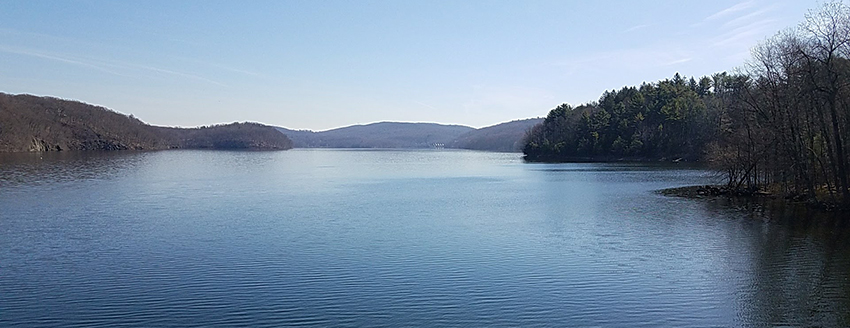
WAC is offering FREE Virtual Watershed Forestry Fieldtrips to the New York City Watershed so you and your students can experience the forests that filter and protect NYC’s drinking water LIVE in your classrooms.
During a Virtual Watershed Forestry Fieldtrip, WAC educators join your class live from the reservoirs, streams and forests of the NYC Watershed and lead your students in hands-on science activities related to watersheds, forest ecosystem services, and stream ecology.
Timing: Timing is flexible – our virtual fieldtrips can run anywhere from 40 minutes to 1.5 hours, depending on your schedule and preference.
Technology: Typically, educators send us a Zoom or Google Meet link to join their class. Alternatively, we can host the fieldtrip through our own Zoom account.
Content : All fieldtrips include visiting a NYC drinking water reservoir to learn about where, why and how the NYC water supply system was built. Additional science content is presented depending on which trip option you choose. Your 3 options include:
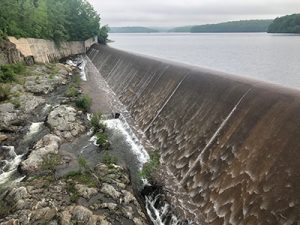
Recommended pre-trip materials:
1. Our Pre-trip Lesson Google Slideshow leads students through a series of inquiries, 2 short videos and 1 short reading. Students will reflect on their own water usage, hypothesize where their tap water comes from, and get an overview of the NYC Watershed, water supply system and the role forests play in filtering and protecting water quality.
2. The NYC-DEP Education Department has created an awesome Virtual Tour of the NYC Watershed and water supply system with embedded videos, images and text that take your students on a journey from raindrops in the Catskill Mountains to their city taps. Consider assigning this individually or jig sawing the content (especially the video content) in groups before your fieldtrip.
Recommended post-trip materials:
1. We strongly encourage you to use our Post-Trip Reflection Padlet , which asks students to share a “thank you” with their trip hosts and to reflect on: Their favorite part of the trip, 3 new things learned, 2 connections between the trip and their coursework, and 1 question they have. WAC educators will respond directly to their questions! – A Template Reflection Padlet can be viewed here. After you book your fieldtrip, you will be sent a unique link to your own class Padlet.
2. In our The Forest is Hiring: Explore Watershed Forest Careers Padlet students are introduced to a diverse array of scientists working in watershed forestry related fields. Students are asked to *star* one or more careers that interest them, describe why they’re interested, and ask the scientist a question about their field or career path. – A Template The Forest is Hiring Padlet can be viewed here. After you book your fieldtrip, you will be sent a unique link to your own class Padlet.
Book your trip: Complete this online form to indicate your scheduling and activity preferences. Email [email protected] with any questions. A minimum of 2-weeks advanced notice is preferred.

- Destinations
- Blue Cruise
- Plan My Trip
Basilica Cistern
Best Known for Heads of Medusa
Civilization Byzantine
Suggested Duration 30 min
Istanbul is a city full of surprises when it comes to breathtaking architecture, and none will surprise you better than Basilica Cistern (Yerabatan Sarnici in Turkish). This must-see treasure of Istanbul sits very close to the iconic Hagia Sophia in Sultanahmet district, but unlike the world-famous mosque, it is located underground. Fun fact; there are as many as 100 big underground cisterns scattered all over Istanbul.
The Basilica Cistern is one of two such cisterns open to the public. Its wondrous architecture makes it the most visited of the two, attracting over one million eager tourists each year. This awe-inspiring achievement of human endeavor dates back to the Byzantine era during the reign of Emperor Justinian I. It served to supply water to the Great Palace (the then seat of the Byzantine rulers) and could hold up to 80,000 cubic meters, attesting to the structure’s sheer colossal size.
Here is everything else you need to know about the magnificent cistern.

Planning a trip to Istanbul soon? Answer this trip planner and get your FREE quotation within 24 hours.
The History
Architecture, heads of medusa, key features, tips & etiquette.
The Basilica Cistern dates back to the Byzantine Emperor Justinian I, who commissioned its construction in the early years of his reign. This was when Constantinople was still recovering from the devastating effects of the Nika revolt, which resulted in the destruction of much of the imperial city and the killing of 30,000 rioters by the Emperor’s troops.
As part of the rebuilding efforts, Justinian commissioned the construction of the cistern in the year 527. The massive structure was completed 38 years later, and it served as a water reservoir for the Great Palace in Constantinople. Water was supplied from the Egrikapi Water Distribution center in the Belgrade Forest.
During the Ottoman era, the cistern was used for a while and was later forgotten for centuries before being accidentally rediscovered in 1545.
The design of the cistern resembles that of a massive basilica. However, the name “Basilica Cistern” has more to do with the fact that it was constructed next to an actual basilica than with its architectural style.
With that said, the cistern is a marvelous achievement of industry and ingenuity. The structure is 143 meters long and 65 meters wide, making it bigger than the standard football pitch. The roof, complete with arches and everything, is supported by 336 Corinthian and Ionic marble columns. Each of the enormous columns measures 9 meters in length, and they are spaced at four-meter intervals and arranged in 12 rows and 28 columns.
Apart from its sheer size, one of the most intriguing features of the Basilica Cistern are the two Medusa heads in the far left-hand corner. The heads are used as column bases; one is tilted to the side while the other is positioned upside down, which adds to their already mysterious stature. No one knows their origin or why they are positioned as they are, but there are still a few rumors that attempt to solve this mystery.
According to Greek mythology, Medusa was one of the most beautiful women of her time. Nonetheless, certain events (there are two versions) led the goddess Athena to curse Medusa into a gorgon whose gaze could turn men into stone even after Jason decapitated her.
In ancient Greek, it was believed that Medusa’s head could avert evil, and one rumor attributes this belief to the use of the two Medusa heads in the underground cathedral. Nonetheless, it could be that they were used because they fit perfectly with the columns.
Some interesting features of the cathedral include:
- Majority of the columns in the Basilica Cistern were recycled from ruins of older buildings.
- These columns were brought from various regions of the empire.
- Fifty-two stone steps are descending into the cistern’s entrance.
- To get to the cistern, water traveled through two aqueducts; the Valens Aqueduct and the Maglova Aqueduct.
- During the Ottoman era, the cistern was rediscovered by accident in the 16th century by the Dutch traveler P. Gyllius.
- While in the city, the explorer heard that residents of the neighborhood could get fresh water by lowering buckets through holes in their ground floors or basements. Rumors said that they could even fish from there.
- To date, the cistern has undergone several restoration periods. The first happened during the Ottoman period in 1723. Later repair works were carried out between 1955 and 1960.
- It was officially opened to the public in 1987 by the Istanbul Metropolitan Municipality.
When visiting the Basilica Cistern, here are a few tips for you:
- If you are interested in photography, don’t forget to mention this to your guide in the morning.
- Always watch your step as some steps might be slippery due to moisture.
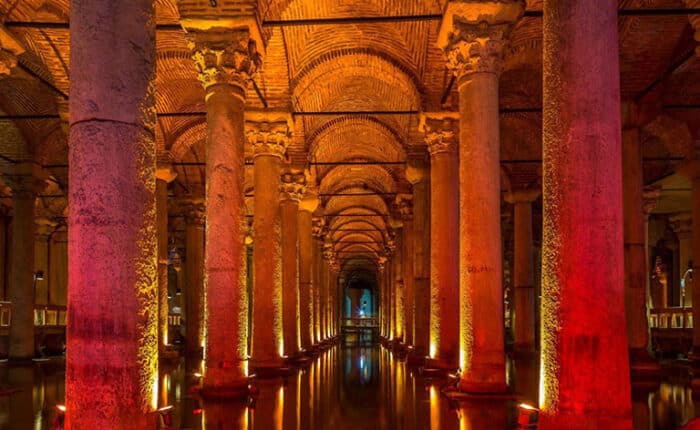
Visiting the Basilica Cistern
The Basilica Cistern sits in the historical Sultanahmet square, and getting there is quite easy. If you are using public transportation, you can get there via a public bus to Eminonu and take a walk to the cistern. The other way to get there using public means is by using the tram running between Kabatas and Zeytinburnu. Alight at the Sultanahmet stop between the Blue Mosque and the Hagia Sophia, and from here, getting to the cistern is just a short walk.
The cistern is open seven days a week; therefore, don’t put too much consideration when planning if it is the only site you will be visiting for the day. On regular days, it opens its doors at 9 am and closes them at 5.30 in the evening. Nonetheless, the opening times change during days of Turkish religious festivals, so watch out if you are visiting during these times.
Once you are there, the entrance fee is 30 TL for foreign travelers, 15 TL for local adults, and free for children under 7 years. Also, you will need a museum card to enter the structure. To avoid all of the hustle, the best way to get to the Basilica Cistern and access it is to book a Made in Turkey Tours tour package. Once you buy one of our tour packages that include the Basilica Cistern, we will handle everything, including transportation and entrance fees.
You will only be able to truly appreciate the beauty of the Basilica Cistern once you descend the 52 stone steps and pass the entrance. The massive structure imposes an equally massive aura of peace on its visitors, and the soft lighting at the column bases is a stunning addition to the cathedral. The lights give the water a beautiful red hue that makes an incredible sight for pictures.
One particular column, the Hen’s Eye column, is a must-see. It is engraved with pictures of a hen’s eye, tears, and slanted branches. The tears on the beautiful column are believed to have been a tribute to the hundreds of slaves who lost their lives during the construction of the cistern.
There are still shallow waters in the cistern, but wooden walkways have been installed to let visitors explore the massive columns. The shallow waters also mean that you will be unable to row a small boat around the cistern as James Bond did in the 1963 film From Russia with Love, which was by the way shot in the Basilica cistern. Another blockbuster movie shot in the cistern is Inferno, a film based on Dan Brown’s novel by the same name.
The waters may be too shallow for a boat, but they are still deep enough for some fish to live in. These fish are another great sight you should watch out for as you walk the cathedral columns.
Istanbul Tours

Istanbul Classics Full-Day (Old City Walking) Tour

Istanbul Bosphorus Cruise Tour with Dolmabahce Palace

Full-Day Bursa Sightseeing Tour from Istanbul

Fener & Balat Walking Tour

Bosphorus Cruise with Maiden’s Tower and the Asian Side

Bosphorus Cruise by Public Ferry with Dolmabahce Palace
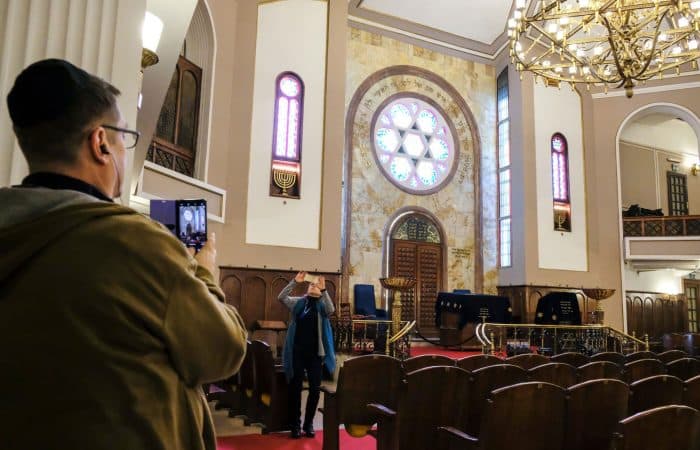
Jewish Heritage Tour of Istanbul
What is nearby.
The Basilica Cistern is located in the Sultanahmet Hippodrome, home to many other breathtaking attractions. These include the Hagia Sophia, Blue Mosque, Hagia Sophia, and Topkapi Palace, a walking distance from the cistern. This is why it is essential to include these other attractions in your tour.

Would like to join the other happy travelers?

Deer and boar could roam forests in the Kakhovka reservoir in 5 years, head of national reserve says
A verdant green forest has sprouted in one of Ukraine’s most unlikely locations — the Kakhovka reservoir left nearly empty after Russia blew up its dam last year.
Following the destruction of the dam on June 6 last year, nearly 20 cubic kilometers of water flooded Ukraine’s four southern oblasts causing a massive humanitarian and environmental crisis.
The vast reservoir, spanning an area nearly the size of London and New York combined, lost 90% of its water, causing water shortages for 700,000 residents. The environmental damage has been catastrophic with pollutants poisoning the soil and natural habitats wiped out.
A year later, 1,600 square kilometers of native poplar and willow trees have sprouted across the former reservoir. The landscape hasn’t been so lush since before the Soviets flooded the plain to construct the dam in 1956.
“This is a huge coincidence,” Mykhailo Mulenko, acting head of the Nature Protection Sector of the Khortytsia National Reserve, told reporters at a press tour in Zaporizhzhia to mark the anniversary of the explosion.
The timing of the attack coincided with the pollination of the willow and poplar trees in May with seeds spreading across the stagnant waters of the reservoir and sinking into the mud. After the reservoir was drained, the seeds, still stuck in the mud, began to germinate and grow rapidly.
“If the Kakhovskaya dam had been blown up in March or August, the situation would have been completely different and much worse,” Mulenko added.
In just one year, the tallest saplings tower up to five meters high and number 20 plants per square meter. The trees have guzzled up recent spring floods, helping their growth.
Mulenko predicts that wild deer and boar could roam the forest in just five years time if conditions remain the same, echoing its pre-Soviet life as part of the Velykyi Luh (Great Meadow).
Under the trees on the north side of the reservoir and the nearby Khortisya Island in Zaporizhzhia Oblast , Ukraine’s Academy of Scientists noted at least 100 species of herbaceous plants and mosses forming a new ecosystem.
The results are promising for a region that experts previously warned could suffer from desertification as a result of the catastrophe.
But the sound of crushed shells when walking through the young forest is a cruel reminder of the price of this new ecosystem.
“A lot of living organisms died in connection with the disaster within the Kakhovka Reservoir. This can be compared to ecocide,” said Svitlana Okhrimenko, deputy director of the Khortytsia National Reserve in Zaporizhzhia.
Ukraine wants to prosecute Russia for what it deems as environmental war crimes , or ecocide. The Environmental Protection and Natural Resources Ministry is documenting cases of damage caused by Russia to Ukrainian land and wildlife and plans to take Moscow to the International Criminal Court (ICC).
Environmental damage has cost Ukraine $60.5 billion, according to Environmental Minister Ruslan Strilets. The Kakhovka crisis alone caused $3.8 billion in damages, including Hr 1.3 billion ($32 million) from the loss of freshwater and Hr 1.2 billion ($30 million) in soil pollution.
“These numbers are dynamic. Calculations are still underway,” said Bohdan Vasyliovych, head of the State Environmental Inspection of the Southern District, Zaporizhzhia, and Kherson oblasts.
Read also: Looking back at the Khakhovka Dam explosion one year later (Photos)
The economic impact on local industries is also large. The reservoir was a source of irrigation for farmland, designed to cover nearly 6,000 square kilometers. Initial calculations from the Agricultural Ministry estimated losses in irrigated land at $800 million.
Fishermen too have paid a hefty price with freshwater fish swept into the Black Sea and fisheries flooded. Last year, the Agricultural Ministry said the industry expects losses of Hr 10 billion ($250 million) and will take years to recover.
In the northern part of the reservoir, close to the village of Malokaterynivka in Zaporizhzhia Oblast, Vasyliovych notes that 10,000 fish corpses were discovered. The amount of fish amounts to about Hr 1.7 million in losses ($42,300).
Around 20 kilometers north of Malokaterynivka lies Khortytsia Island, a sacred place in Ukraine once home to the Zaporizhzhian Cossacks . Water levels dropped by five meters around the island adding 1.8 square kilometers of land.
Nearly a square kilometer of lakes dried up around Khortytsia Island, uncovering hidden artifacts including a historic longboat but killing wildlife and rare aquatic plants in the process.
The lakes that remain have shrunk and are no longer connected to the Dnipro River, causing overheating that suffocates aquatic wildlife.
The nearby Dnipro Dam, which served the upper end of the Kakhovka reservoir, gushes out water from the Dnipro River but at a fluctuating rate. While this spring saw water levels rise once more, they have since retracted, displaying rocks and sand previously submerged.
Okhrimenko says vegetation has also returned to areas around the island, but stresses that it is currently impossible to grasp the full extent of the damage as Ukraine doesn’t yet have the capabilities to account for all the small organisms harmed by the catastrophe.
It will take years before Ukraine has those results.
Read also: Russian forces destroy Kakhovka dam, triggering humanitarian disaster

Drinking Water Reservoirs
We operate several water storage facilities downstream of our Cedar River and Tolt River source water treatment facilities. These locations provide us with the capabilities and flexibility to provide clean and consistent water service to your tap.
We have replaced six open reservoirs with underground structures to improve the quality and security of our water supply. The Seattle Parks and Recreation Department constructed recreational open space improvements over the covered reservoirs. The reservoir covering program provided 90 acres of new open space, including Magnolia (Magnolia Manor Park), Lincoln (Cal Anderson Park), Myrtle (Myrtle Reservoir Park), Beacon (Jefferson Park), West Seattle (Westcrest Park), and Maple Leaf (Maple Leaf Reservoir Park).
Roosevelt and Volunteer Reservoirs remain uncovered and are now disconnected from the rest of the drinking water system. They provide critical emergency water resources for our customers. For example, in the event of a major earthquake, the reservoirs would serve as a vital source for emergency water and fire-fighting purposes.
Contact Matt Orr at [email protected] or (206) 733-9169 for general information, or contact Andrew Karch at [email protected] or (206) 684-4643 for information about the Lake Forest Park Reservoir Covering Project.
Public Utilities
Andrew Lee, General Manager and CEO Address: 700 5th Avenue, Suite 4900, Seattle, WA, 98104 Mailing Address: PO Box 34018, Seattle, WA, 98124-5177 Phone: (206) 684-3000 Email: [email protected]
Newsletter Updates
Sign up for the latest updates from Public Utilities
Citywide Information
- Elected Officials
- Open Data Portal
- Public Records
- City Holidays and Closures
- City News Feed
- City Event Calendar
- All City Newsletters
- View the Departments & Agencies List
Popular Pages
- Look Up Collection Day
- Bills & Payments
- Where Does It Go? Tool
- Accounts & Payments
- Special Item Collections
Seattle Public Utilities (SPU) is comprised of three major direct-service providing utilities: the Water Utility, the Drainage and Wastewater Utility, and the Solid Waste Utility.
Spring Valley Reservior

Top ways to experience nearby attractions

Most Recent: Reviews ordered by most recent publish date in descending order.
Detailed Reviews: Reviews ordered by recency and descriptiveness of user-identified themes such as wait time, length of visit, general tips, and location information.
Also popular with travelers

Spring Valley Reservior - All You Need to Know BEFORE You Go (2024)
Design of the Position of the Blocking Material in a Water-Flooded High-Permeability Interlayer of an Oil Reservoir for a Five-Spot Flooding Scheme
- Published: 05 June 2024
- Volume 79 , pages 150–161, ( 2024 )
Cite this article

- K. A. Potashev ORCID: orcid.org/0000-0001-7107-2974 1 ,
- V. V. Baushin 2 ,
- A. B. Mazo ORCID: orcid.org/0000-0003-0003-2670 1 ,
- R. G. Ramazanov 3 &
- V. V. Shelepov 3
Explore all metrics
The article presents a comparative analysis of the efficiency of various arrangements of a blocking material in a thin, high-permeability water-cut layer of an oil reservoir in order to reduce unproductive injection and increase oil recovery. The efficiency was was calculated by high-resolution numerical simulation in the vertical section of a typical stream tube for a five-spot water-flooding scheme. Three types of position of the blocking intervals are considered for two representative ratios of the viscosity of the water and oil phases.
This is a preview of subscription content, log in via an institution to check access.
Access this article
Price includes VAT (Russian Federation)
Instant access to the full article PDF.
Rent this article via DeepDyve
Institutional subscriptions

Altunina, L.K., Kuvshinov, V.A., and Stas’eva, L.A., Thermoreversible polymer gels for enhanced oil recovery, Khim. Interesakh Ustoich. Razvit. , 2011, vol. 19, pp. 127–136.
CAS Google Scholar
Bai, B., Wang, Q., Du, Y., and Liu, Y.Z., Factors affecting in-depth gel treatment for reservoirs with thick heterogeneous oil layers, in Petrol. Soc. 5th Canadian International Petrol. Conf., Calgary, Alberta, Canada, 8–10 June, 2004, Paper 2004–140 , Calgary, Alberta, Canada, 2004, pp. 1–8. https://doi.org/10.2118/2004-140
Barenblatt, G.I., Entov, V.M., and Ryzhik, V.M., Dvizhenie zhidkostei i gazov v prirodnykh plastakh (Theory of Fluid Flows Through Natural Rocks), Moscow: Nedra, 1984.
Bakhshyan, N.A., The reduction of water content of wells with flow diverter technology on the example of Vankor Field, Mezhd. Nauchno-Issled. Zh. , 2016, vol. 6, no. 48, pp. 33–37.
Chekalin, A.N., Konyukhov, V.M., and Kosterin, A.V., Dvukhfaznaya mnogokomponentnaya fil’tratsiya v neftyanykh plastakh slozhnoi struktury (Two-Phase Multicomponent Filtration in Oil Reservoirs of Complex Structure), Kazan: Kazan. Gos. Univ., 2009.
Fletcher, A.J.P., Flew, S., Forsdyke, I.N., et al., Deep diverting gels for very cost-effective waterflood control, J. Petrol. Sci. Eng. , 1992, vol. 7, pp. 33–43. https://doi.org/10.1016/0920-4105(92)90006-m
Article CAS Google Scholar
Gao, H.W., Chang, M.M., Burchfield, T.E., and Tham, M.K., Permeability modification simulator studies of polymer-gel-treatment initiation time and crossflow effects on waterflood oil recovery, SPE Reservoir Eng. , 1993, vol. 8, no. 3, pp. 221–227. https://doi.org/10.2118/20216-pa
Ghahfarokhi, A., Kleppe, J., and Torsaeter, O., Simulation Study of Application of a Water Diverting Gel in Enhanced Oil Recovery. Paper SPE-180190-MS , 2016.
Khamees, T., Flori, R.E., and Wei, M., Simulation study of in-depth gel treatment in heterogeneous reservoirs with sensitivity analyses, in 2017 SPE Western Regional Meeting.Paper SPE-185716-MS , 2017, pp. 1–23.
Mazo, A.V. and Potashev, K.A., Superelementy. Modelirovanie razrabotki neftyanykh mestorozhdenii: Monografiya (The Superelements. Modeling of Oil Fields Development), INFRA-M Acad. Publ. LLC., 2020.
Mazo, A.B., Potashev, K.A., Baushin, V.V., and Bulygin, D.V., Numerical simulation of oil reservoir polymer flooding by the model of fixed stream tube, Georesursy , 2017, vol. 19, no. 1, pp. 15–20.
Oil and gas of Western Siberia, in Mater. Mezhd. nauchno-tekhn. konf., posvyashch. 55-letiyu Tyumenskogo gos. neftegaz. univ. T. 1 (Mater. Int. Sci. Pract. Conf., Devoted to 55th Anniversary of Tyumen State Oil and Gas University. Vol. 1), Danilov, O.F, Ed., Tyumen: Tyumen. Gos. Neftegaz. Univ., 2011.
Potashev, K.A. and Akhunov, R.R., Estimation of the heterogeneity of the reservoir fluid inflow to the cross-sectional contour of a vertical well, Uch. Zap. Kazan. Univ. Ser. Fiziko-Mat. Nauki , 2020, vol. 162, no. 2, pp. 180–192.
Google Scholar
Potashev, K.A. and Mazo, A.B., Numerical modeling of local effects on the petroleum reservoir using fixed streamtubes for typical waterflooding schemes, Georesursy , 2020, vol. 22, no. 4, pp. 70–78.
Article Google Scholar
Potashev, K.A. and Mazo, A.B., Mathematical modeling of oil reservoir waterflooding using fixed streamtube at various values of viscosity ratio, Lobachevskii J. Math. , 2021, vol. 42, no. 8, pp. 2023–2029.
Potashev, K.A., Mazo, A.B., Ramazanov, R.G., and Bulygin, D.V., Analysis and design of a section of an oil reservoir using a fixed stream tube model, Neft’. Gaz. Novatsii , 2016, no. 4, pp. 32–40.
Potashev, K.A., Kulichkova, K.A., and Baushin, V.V., Efficiency of High-permeability interlayer isolation with different location of blocking material, Neft’. Gaz. Novatsii , 2020, no. 7, pp. 54–58.
Potashev, K.A., Akhunov, R.R., and Mazo, A.B., Calculation of the flow rate between wells in the flow model of an oil reservoir using streamlines, Georesources , 2022, vol. 24, no. 1, pp. 27–35.
Shelepov, V.V., Bulygin, D.V., Mazo, A.B., et al., TubeGeo, Versiya 1.0. TubeGeo, versiya 1.0. Simulation of Geological and Technical Measures by the Method of Flow Tubes. Certificate of State Registration of the Computer Program. No. 2016611381 (February 1, 2016).
Shelepov, V.V., Bulygin, D.V., Ramazanov, R.G., and Baushin, V.V., Komp’yuternye modeli dlya analiza effektivnosti metodov vozdeistviya na plast (Numerical Models for Analysis of Effectiveness of the Recovery Methods), Moscow: KDU, Univ. kniga, 2017.
Sizov, N.E., Pozdniakov, S.P., and Muromets, N.N., Impact of planned heterogeneity of hydraulic conductivity on the results of pumping in an isolated unconfined layer, Moscow Univ. Geol. Bull. , 2022, vol. 1, no. 3, pp. 113–123.
Spirina, E.A., Potashev, K.A., and Mazo, A.B., Evaluation of the reliability of the averaging over the reservoir thickness for the model with a fixed streamtube, J. Phys.: Conf. Ser. , 2019, vol. 1158, 042024. https://doi.org/10.1088/1742-6596/1158/4/042024
Stavland, A., Kvanvik, B.A., and Lohne, A., Simulation Model for Predicting Placement of Gels, in Proc. SPE Annu. Techn. Conference and Exhibition. Paper SPE-28600-MS , Soc. Petrol. Eng., 1994, pp. 1–16. https://doi.org/10.2523/28600-ms
Suleimanov, B.A. and Feyzullayev, K.A., Numerical simulation of water shut-off for heterogeneous composite oil reservoirs (Russian), in SPE Annu. Caspian Techn. Conf., 16–18 October, Baku, Azerbaijan. Paper SPE-198388-RU , Soc. Petrol. Eng., 2019, pp. 1–10. https://doi.org/10.2118/198388-ru
Vossoughi, S. and Buller, C.S., Permeability modification by in-situ gelation with a newly discovered biopolymer, SPE Reservoir Eng. , 1991, vol. 6, no. 4, pp. 485–489.
Willhite, G.P., Waterflooding, SPE Textbook Series , Richardson, TX, 1986.
Book Google Scholar
Zakirov, S.N., Roshchina, I.V., Indrupskii, I.M., and Roshchin, A.A., Razrabotka mestorozhdenii nefti i gaza s superkollektorami v produktivnom razreze (Development of Oil and Gas Superreservoirs in the Pay Zone), Moscow: OOO “Kontent-press”, 2011.
Download references
The study was supported by the Strategic Academic Leadership Program of Kazan (Volga Region) Federal University (PRIORITY 2030).
Author information
Authors and affiliations.
Lobachevsky Institute of Mathematics and Mechanics, Kazan Federal University, 420008, Kazan, Russia
K. A. Potashev & A. B. Mazo
IMPEL LLC, 420111, Kazan, Russia
V. V. Baushin
Moscow State University, 119991, Moscow, Russia
R. G. Ramazanov & V. V. Shelepov
You can also search for this author in PubMed Google Scholar
Corresponding authors
Correspondence to K. A. Potashev , V. V. Baushin , A. B. Mazo , R. G. Ramazanov or V. V. Shelepov .
Ethics declarations
The authors of this work declare that they have no conflicts of interest.
Additional information
Translated by V. Prikhodko
Publisher’s Note.
Allerton Press remains neutral with regard to jurisdictional claims in published maps and institutional affiliations.
About this article
Potashev, K.A., Baushin, V.V., Mazo, A.B. et al. Design of the Position of the Blocking Material in a Water-Flooded High-Permeability Interlayer of an Oil Reservoir for a Five-Spot Flooding Scheme. Moscow Univ. Geol. Bull. 79 , 150–161 (2024). https://doi.org/10.3103/S0145875224700169
Download citation
Received : 05 June 2023
Revised : 16 August 2023
Accepted : 22 January 2024
Published : 05 June 2024
Issue Date : February 2024
DOI : https://doi.org/10.3103/S0145875224700169
Share this article
Anyone you share the following link with will be able to read this content:
Sorry, a shareable link is not currently available for this article.
Provided by the Springer Nature SharedIt content-sharing initiative
- oil reservoir
- high-permeability layer
- early watering
- water inflow blocking
- numerical simulation
- two-phase flow in porous media
- high-resolution stream tube model
- Find a journal
- Publish with us
- Track your research

IMAGES
VIDEO
COMMENTS
The Buffalo Bayou Park Cistern is a former drinking water reservoir built in 1926 for the City of Houston. BBP restored and repurposed the 87,500 square-foot Cistern into a magnificent public space for tours, performances, and art installations. Reservations are required to visit the Cistern. Children ages 9+ only.
Visit the Columbia South Shore Well Field, the city's groundwater source. Walk through old-growth forest in the upper reaches of the Bull Run Watershed. Eat lunch at the Historic Bear Creek House, overlooking Dam 1 and Reservoir 1. Tour the city's 1929 concrete dam, and the adjacent forest. Drive across the city's 1962 earth and rock fill dam.
The tour follows the flow of the water supply starting at the north end of Sooke Lake Reservoir and explores the surrounding forests, Rithet Creek (main tributary to Sooke Lake Reservoir), water supply facilities and the treatment process that ensures the water delivered to your tap is the highest quality.
Watershed Tours. Email. Metrotower III, 4515 Central Boulevard, Burnaby, BC, V5H 0C6. Discover the treasures of the watersheds, where ancient trees tower in steep mountain valleys, wildlife abounds and water flows through natural landscapes to our drinking waters supply system. Metro Vancouver manages three protected watersheds to provide 2.8 ...
We invite the public to tour sites along the State Water Project and learn more about California's water at Lake Oroville (Butte County in Northern California), San Luis Reservoir (Merced County in Central California), and Pyramid Lake (Los Angeles County in Southern California).Each center is staffed by knowledgeable guides and offers exhibits and videos that highlight California's world ...
The Manasquan Reservoir is a source of water for municipalities and utilities. The Reservoir is also a natural setting for recreational activities and outdoor pursuits. ... These 45-minute tours of the Manasquan Reservoir, Howell, are narrated by Park System Naturalists and include opportunities to view local wildlife including turtles, egrets ...
All trips include a visit to a NYC-DEP drinking water reservoir. There are 2 rounds of funding each year with applications due in early January & August and partial funding is often awarded primarily for transportation costs. Grantees receive half of the grant award up front and the second half as reimbursement after the tour. How to Apply
Spring Valley Reservoir. 20 miles from Moscow, Idaho is the Spring Valley Reservoir, locally known for its habitat and bird observation features. Song birds, water birds, and water fowl can all be spotted in the 99 acre region. Boating, kayaking, canoeing, and fishing are permitted on this site in the lake, as well as Idaho Birding Trails to ...
Watershed tours include dam tours, old growth guided walks, wetlands tour, fungi tours and many more. There are also guided hikes in winter. The signature tours are a 1-hour family watershed tour and a 2.5 hour watershed tour. The 1-hour tour includes a drive to the historic townsite of Cedar Falls and a visit to Cedar Falls (the waterfall).
The Water Education Foundation's tours offer participants a firsthand look at the water facilities, rivers and regions critical in the debate about the future of water resources. Issues of water supply, water quality, environmental restoration, flood management, groundwater and water conservation are addressed by a wide range of speakers representing different viewpoints.
Denver Water's reservoirs, canals and canyons offer lots of opportunities to get out and play. Explore our recreation sites for ways you can enjoy Colorado's great outdoors. , ... Treat your curiosity about water quality to a virtual tour of our potable treatment process. Follow the journey of water from snowflake to tap. Construction ...
The Water Supplies Department (WSD) has already launched a virtual tour of the service reservoir. WSD now allows restricted opening of the service reservoir for visiting by the public. The visiting programme will be conducted in the form of guided tours with a view to enhance public's understanding of the historical background and appreciate ...
The Waterworks Museum interprets the unique stories of one of the country's first metropolitan water systems through exhibitions and educational programs on engineering, architecture, social history, public health, and Safe Water Access. ... Chestnut Hill Reservoir Historic Walking Tour June 9, 2024 • 10am. Special Access Tour - 2:45pm June ...
Underground Cistern. Known locally as Yerebatan Sarayi (meaning Sunken Palace) or Yerebatan Sarnici (Sunken Cistern), this underground water cistern was the major water reservoir of Constantinople.The water was transported from the Belgrade Forest by the immense Byzantine aqueducts (Valens Aqueducts).You can visit the Underground Cistern either with our One Day in Istanbul or Istanbul Layover ...
1. NYC Watersheds & Reservoirs - Live from a NYC drinking water reservoir & watershed forest. Learn about watersheds, the NYC water supply system and the role trees play in filtering and protecting water quality for NYC. - Check out our NYC Watershed & Reservoirs Google Earth Tour that introduces themes and locations related to this trip . 2.
The massive structure was completed 38 years later, and it served as a water reservoir for the Great Palace in Constantinople. Water was supplied from the Egrikapi Water Distribution center in the Belgrade Forest. ... To avoid all of the hustle, the best way to get to the Basilica Cistern and access it is to book a Made in Turkey Tours tour ...
The vast reservoir, spanning an area nearly the size of London and New York combined, lost 90% of its water, causing water shortages for 700,000 residents. The environmental damage has been ...
They provide critical emergency water resources for our customers. For example, in the event of a major earthquake, the reservoirs would serve as a vital source for emergency water and fire-fighting purposes. Contact Matt Orr at [email protected] or (206) 733-9169 for general information, or contact Andrew Karch at [email protected] ...
The Chimney Hollow Reservoir Project is a collaborative effort by 12 Northeastern Colorado water providers to improve the reliability of the Windy Gap Project. Chimney Hollow Reservoir will be located just west of Carter Lake in Larimer County. Its 90,000 acre-feet of dedicated storage capacity will supply a reliable 30,000 acre-feet of water ...
Use corn or worms or both. A hidden jewel 30 minutes from Moscow. Get the kids a treat at the Troy gas station on the way. In the summer when it's hot at night, take your wife here when there is a full moon. Go out on the dock with your best chairs, and sit and watch the moon. Spring Valley is great! Go.
The Conservation Gardens and adjacent Colorado-Big Thompson Project Interpretive Area offer self-guided tours during daylight hours year-round. The gardens demonstrate water-efficient landscaping options for homeowners, commercial property owners and homeowners associations. The interpretive area is a small-scale replica of key C-BT Project features in a contemplative setting.
The entity disclosed that during a media tour hosted earlier today, at the Joburg Water's Randburg System, along with its two critical reservoirs and water towers. The tour was aimed at ...
Reservations can be made online, or through the park's reservation call center at 1-888-409-7579, beginning at 9:00 a.m. The maximum stay will be limited to 7 nights. Regular camping fees will be charged like other state park camping areas. Every remote campsite has a maximum occupancy of 6 people, unless otherwise posted.
McALLEN, Texas (Border Report) — The South Texas border city of Laredo has implemented Stage 3 water restrictions as levels at both regional reservoirs are at historic and critically low levels.Laredo residents will only be allowed to water their lawns and hand wash their vehicles once a week. However, carwash businesses may still operate as long as they use recycled water.
Abstract The article presents a comparative analysis of the efficiency of various arrangements of a blocking material in a thin, high-permeability water-cut layer of an oil reservoir in order to reduce unproductive injection and increase oil recovery. The efficiency was was calculated by high-resolution numerical simulation in the vertical section of a typical stream tube for a five-spot water ...